
Roger Joseph Zelazny was an American poet and writer of fantasy and science fiction short stories and novels, best known for The Chronicles of Amber. He won the Nebula Award three times and the Hugo Award six times, including two Hugos for novels: the serialized novel ...And Call Me Conrad (1965), subsequently published under the title This Immortal (1966) and then the novel Lord of Light (1967).
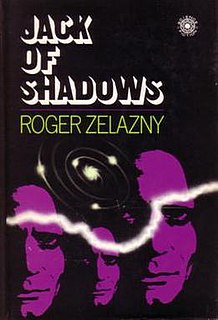
Jack of Shadows is a science fantasy novel by American author Roger Zelazny. According to him, the name of the book was an homage to Jack Vance. In his introduction to the novel he mentioned that he tried to capture some of the exotic landscapes that are frequent in Vance's work. Zelazny wrote it in first draft, with no rewrites. The novel was serialized in the Magazine of Fantasy and Science Fiction in 1971 and published in book form that same year. It was nominated for a 1972 Hugo Award and finished #4 in the 1972 Locus Poll for Best Novel.
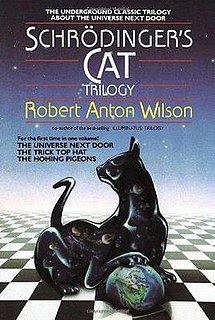
The Schrödinger's Cat Trilogy is a trilogy of novels by American writer Robert Anton Wilson consisting of The Universe Next Door, The Trick Top Hat, and The Homing Pigeons, each illustrating a different interpretation of quantum physics. Wilson is also co-author of The Illuminatus! Trilogy (1975), and Schrödinger's Cat is a sequel of sorts, re-using several of the same characters and carrying on many of the themes of the earlier work.

Jesus on Mars is a 1979 science fiction novel by American writer Philip José Farmer, set on Mars and involving an alien civilization. It makes social commentary on a just society and on religious belief.

Lord Valentine's Castle is a novel by Robert Silverberg published in 1980.

The Dream Master (1966), originally published as a novella titled He Who Shapes, is a science fiction novel by American writer Roger Zelazny. Zelazny's originally intended title for it was The Ides of Octember. It won the 1965 Nebula Award for Best Novella.

Expanded Universe, The New Worlds of Robert A. Heinlein is a 1980 collection of stories and essays by American writer Robert A. Heinlein. The trade paperback 1981 edition lists the subtitle under other Heinlein books as More Worlds of Robert A. Heinlein because the contents subsume the 1966 Ace Books collection, The Worlds of Robert A. Heinlein. The current volume is dedicated to William Targ.

Deus Irae is a post-apocalyptic science fiction novel started by American author Philip K. Dick and finished with the help of American author Roger Zelazny. It was published in 1976. Deus irae, meaning God of Wrath in Latin, is a play on Dies Irae, meaning Day of Wrath or Judgment Day. This novel was based on Dick's short story "The Great C".

NESFA Press is the publishing arm of the New England Science Fiction Association, Inc. The NESFA Press primarily produces three types of books:

Madwand is a 1981 fantasy novel by American writer Roger Zelazny. It is a sequel to Changeling.

To Die in Italbar (1973) is a science fiction novel by American writer Roger Zelazny. To Die in Italbar follows Mr. H, a man who needs only to touch someone to heal or hurt them, during a deadly galactic pandemic.

This Immortal, serialized as ...And Call Me Conrad, is a science fiction novel by American author Roger Zelazny. In its original publication, it was abridged by the editor and published in two parts in The Magazine of Fantasy and Science Fiction in October and November 1965. It tied with Frank Herbert's Dune for the 1966 Hugo Award for Best Novel.
This is a partial bibliography of American science fiction and fantasy author Roger Zelazny.

Watchtower is a fantasy novel by American writer Elizabeth A. Lynn published in 1979.
The Man Who Corrupted Earth is a novel by G. C. Edmondson published in 1980.
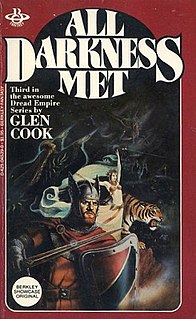
All Darkness Met is a novel by Glen Cook published in 1980.
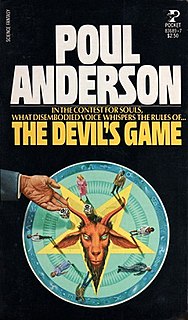
The Devil's Game is a novel by Poul Anderson published in 1980.
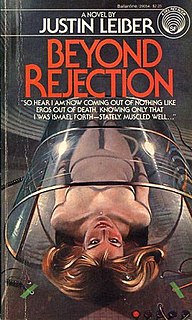
Beyond Rejection is a novel by Justin Leiber published in 1980.
Stardrifter is a novel by Dale Aycock published in 1981.
Dale Aycock is an American author of science fiction.
















